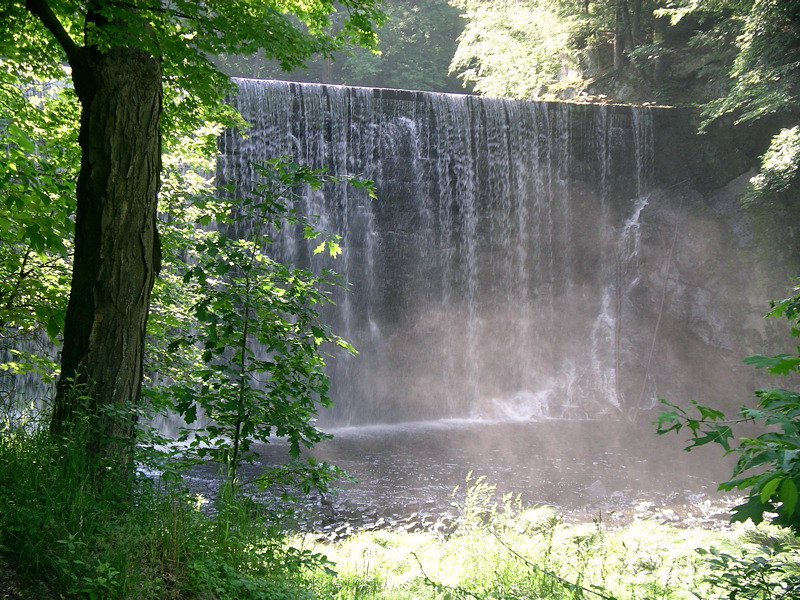Town Awarded Design Grant for Puffer’s Pond Dam and Dike Repairs

Puffer's Pond Dam. Photo: pjmorse/ Flckr.com (CC BY-SA 2.0)
Source: amherstma.gov
A significant step in addressing some of the needs at Puffer’s Pond will move forward with the awarding of a $250,000 grant to design much-needed repairs for the dam and dike. This funding is part of the Healey-Driscoll Administration’s award of nearly $14 million to help 23 municipalities and nonprofit organizations across Massachusetts address critical repairs and safely remove outdated structures through the Executive Office of Energy and Environmental Affairs’ Dam and Seawall program.
Puffer’s Pond is a beloved public recreation and conservation destination for Amherst residents and visitors alike. Both the dam and dike are in need of repairs due to vegetation growth, erosion, and structural vulnerabilities. These repairs are vital to preparing for potential floods and to maintaining access to the pond for fishing, birdwatching, walking, kayaking, and swimming.
“Securing this grant is a significant step forward in our efforts to preserve and protect Puffer’s Pond,” said Assistant Town Manager David Ziomek. “Puffer’s Pond is being ‘loved to death,’ often attracting thousands of users each season to escape the heat and engage in a variety of recreation activities. As we work to find the right balance between preservation and public access, these repairs will enhance the safety and stability of the area while also protecting the vital ecosystems within.”
Built in the 1890s to provide power to mill operations, the 32-foot-high dam spans the width of the Mill River and provides a picturesque waterfall in all seasons. The dike is a 4-foot-high earthen embankment structure that was constructed at a low point along what is now the normal pool shoreline. The actual date of the dike’s construction is not known, but it likely coincided with the dam’s construction to maintain power-generating water levels in the pond. The Massachusetts Department of Conservation and Recreation Office of Dam Safety lists both structures as needing maintenance and repairs.
The overall goals of the project are to make the pond, the dam, and the dike safer and ultimately more resilient. Once the repairs and improvements are designed and implemented it will ensure the pond’s long-term viability as an essential community resource.
“Puffer’s Pond is a true treasure for the Town. People enjoy the pond and its conservation areas in all seasons,” said Town Manager Paul Bockelman. “Investing in the upkeep and protection of this site is not just an environmental necessity, it’s a commitment to the well-being of our community for generations to come.”
Funding from this grant will be used to hire an engineering firm specializing in dam repairs to conduct multiple assessments, design plans, and pursue permitting through state and federal agencies. Once the project design and permitting are complete the Town will seek additional funding to execute the repairs.
These repairs are a vital element of the Puffer’s Pond Vision Plan which aims to restore, protect, and enhance ecologically sensitive areas of the pond while creating a more accessible and safe destination for all to enjoy. The Vision Plan will enable the town to continue to accommodate and grow the dedicated use of this locally and regionally significant place while also achieving the conservation goals for the area.
The Executive Office of Energy and Environmental Affairs’ Dam and Seawall program offers financial resources to qualified applicants for projects that aim to enhance, preserve, and protect the natural resources and the scenic, historic and aesthetic qualities of the Commonwealth of Massachusetts. Established in 2013, this program has provided over $134 million in grants and loans to repair or remove deficient dams, seawalls, and levees.
Learn more about the Dam and Seawall Repair program.

Due to E. coli, Puffers was closed for swimming for much of the summer. It would be nice to see the town use some CPA funding to try to fix this problem.
Questionable use of CPA funds, they’re not to be used for ordinary maintenance.
I don’t know for certain, but it seems possible that CPA funds could be used to help in addressing “issues” at Puffer’s Pond.
(https://www.communitypreservation.org/allowable-uses)
Unfortunately, I have been told that the E.coli. problem is, in part, due to low stream flows and, a small pond, water stagnation as it sits in the sun. I would guess that neither natural occurrence can be practically mitigated, if at all.
On a side note: My 3 sons (outdoors guys all) were delighted growing up just a quick walk or bike ride from Puffer’s. However, as the frequency of dogs roaming (free or with their humans) began to increase in the 1990s, coincidental problems began to arise. Aside from several occasions when a (“He’s friendly and just happy”) dog would swoop down a pond embankment to jump in the water (once knocking down my then six-year whose head went crashing under water), two of my boys began to break out in a rash after being in the pond.
Although I had dog pets my entire childhood as did my sons, we never brought one to Puffer’s. As dogs appeared at the pond and its surrounds more and more often, I became annoyed and concerned and asked the boys to refrain from swimming there. I did some research and, yep, dog poop can contain dangerous pathogens, including Giardia, Salmonella, E. coli, and others. Dog poop (deposited near or in water or from a dog’s skin or coat) breaks down more slowly than wild animal poop. This slow decomposition means harmful bacteria and parasites build up and persist longer, contaminating ponds, streams and lakes.
I remain surprised that dogs are allowed anywhere near Puffer’s Pond or on public land where other water sources exist.
I’ll add an addendum to my earlier post as this writer captured my sentiments exactly.
https://www.washingtonpost.com/opinions/2024/10/14/dogs-parks-leash-wildlife/